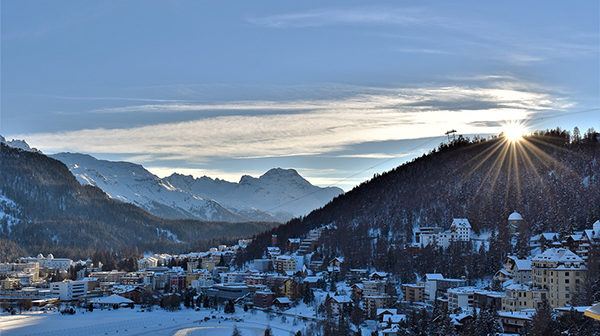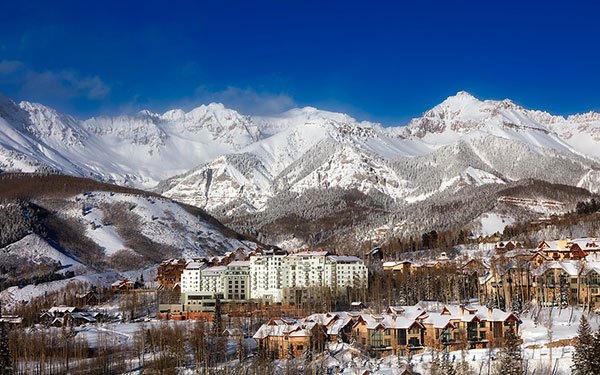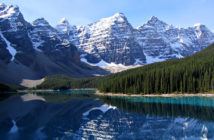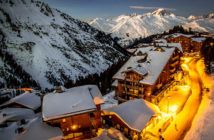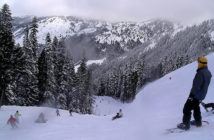Wondering which is the best country in the world for skiing? Wonder no more…
As powder hungry humans we are blessed with incredible ski and snowboard destinations all over the world.
But which are the best?
To be honest, it’s subjective, as it depends on what is most important to each individual – the deepest, fluffiest snow? The most insane terrain? The best facilities for families? The most indulgent après ski?
We’ve put together this absolute whopper of a guide to the world’s top ski resorts which tick all those boxes, and more…
Contents
- 1 Best Ski Resorts in the USA
- 2 Best Ski Resorts in Japan
- 3 Best Ski Resorts in Andorra
- 4 Best Ski Resorts in Canada
- 5 Best Ski Resorts in France
- 6 Best Ski Resorts in Austria
- 7 Best Ski Resorts in Switzerland
- 8 Best Ski Resorts in Norway
- 9 Best Ski Resorts in Slovenia
- 10 Best Ski Resorts in Finland
- 11 Best Ski Resorts in Iceland
- 12 Best Ski Resorts in Romania
- 13 Best Ski Resorts in Italy
Best Ski Resorts in the USA
Telluride, Colorado
Consistently featuring high in the polls for having some of the best overall ski terrain in North America, Telluride in Colorado has the perfect blend of stunning mountain vistas, a vast 2000 acre terrain with an excellent hi tech lift infrastructure, uncrowded slopes, a vertical drop of 4425 feet from the dizzying peaks 13000 foot high peaks, and 280 inches of natural seasonal snowfall.
The terrain here really does have something for everyone, with increasingly more trails being opened.
Beginner slopes and kids facilities are based right next to the Mountain Village accommodations — which is one of the reasons why Telluride is so popular with families.
Currently of the 148 runs 16% are green singles and doubles so there is plenty of scope for gentle progression for beginners — as well as some picturesque long runs high up on the mountain.
Likewise, the 29% intermediate runs are split into single and double blues to make progression a breeze, and there is even a there is a self-contained canyon area just for the pleasure of advanced intermediates, as well as glade skiing, bowls, and more.
Advanced and expert skiers and snowboarders have got plenty to get excited about too. Exhilarating steep groomers, tons of moguls, excellent tree skiing, wide bowls, chutes, peaks, and backcountry — some of which rates as extreme terrain — plus ‘The Plunge’, a jaw-dropping black diamond 3,140 vertical foot descent from the top of the mountain down to Telluride town. There are also 3 awesome terrain parks for all skill levels.
Take a look at this video for some handy Telluride tips:
It’s not just the terrain that has something for everyone.
The pretty, historic mining town of Telluride oozes charm and low key sophistication, and provides a wide range of top class restaurants and excellent shopping, as well as the chance to let off some steam until late in one of the various cozy pubs and chic bars.
The Mountain Village offers more for those on a tighter budget, with some fun spots for après ski entertainment.
The exception to this is the glorious but expensive Alpino Vino which offers fine wines, a terrace with breathtaking views, and divine five course Italian style dining (dinner guests are transported by snowcat).
>>> Read more: The 7 Best Ski Resorts in Colorado
Park City, Utah
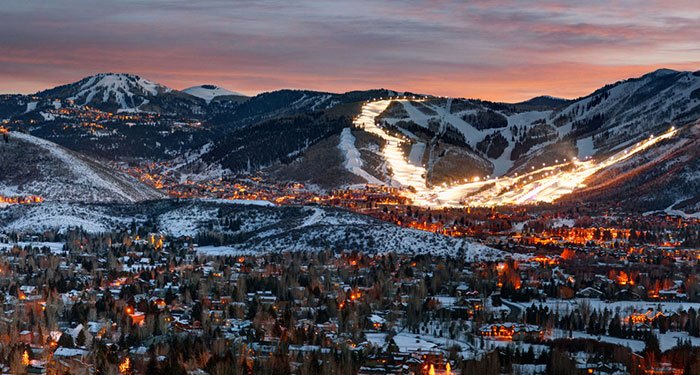
By PeteysHead (CC BY-SA 4.0 licence)
For the biggest skiing in the US, head to Park City in Utah with an immense 7300 acres of skiable terrain.
However, as the saying goes, it’s not just size that matters, but thankfully Park City’s broad, steep slopes have got much more to offer too, including a 10000 foot high summit, 3200 foot vertical, a whopping 355” average seasonal snowfall, plenty of fantastic varied terrain, and a world famous resort town.
It also has some of the best terrain parks in the world which attract snowboarders from all around, as well as some gnarly ungroomed terrain and canyons.
Expert and advanced skiers get to play on more than 50% of the 345 available trails, with excellent steep terrain, bumps, backcountry, lots of double diamonds, bowls with gladed terrain, cliffs, couloirs, and cat and heli-skiing.
41% of runs are blue and are well serviced by lifts, so there’s plenty to appeal to intermediates too including long, fast cruisers, wide groomers with spectacular views, and some steeper blue mogul runs.
When you look at the percentages, it may not appear that there is much for beginners here, but because the resort is so huge there is in fact lots to occupy the novice skier, with two dedicated slow zone areas, a dedicated 7 acres of beginners area, and the possibility to ski all the way from mountain top to base at Park City. And if all this isn’t enough for you, the adjacent Deer Valley ski resort is on the edge of town and easily reached by a free bus.
If you want to party — congratulations you’ve just found Utah state’s ski party central! Renowned as the location for the Sundance Film Festival, ski-in/ski-out Park City is a sprawling cosmopolitan town packed with quirky boutiques and galleries, stylish bars, restaurants, and spas, and cool clubs.
This was originally a silver mining town, and these days it mostly attracts well-heeled visitors — many of whom couldn’t give two hoots for the skiing, they just come to see and be seen and enjoy everything the town has to offer.
The elegant and characterful Main Street is where most of the action takes place, although there are also good options on the outskirts of town and at the Park City ski resorts’ main mountain base — including the unique opportunity to sample a delicious multiple course Norwegian banquet in a viking yurt.
>>> Read more: The 6 Best Ski Resorts in Utah
Jackson Hole, Wyoming
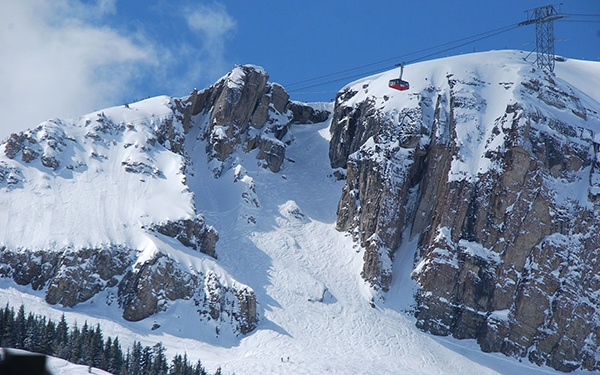
By Enricokamasa (public domain)
The sometimes savagely steep and endlessly entertaining slopes of Jackson Hole have been pivotal to this Wyoming ski resort achieving cult status among skiers and snowboarders alike.
2500 acres of terrain are spread across 2 mountains, with a vertical drop of 4139 feet.
This is a great resort for powderhounds who love the 460” average quality seasonal snowfall, as well as thrill seekers and hardcore skiers who get their kicks on the steep, challenging terrain.
Nearly 60% of Jackon’s terrain is black or double black, with hair raising cliffs and steeps, chutes and tree runs, 2 bowls, bumps and the legendary Corbet’s Couloir — not to be attempted by the faint of heart. In addition there are more than 3,000 acres of gated backcountry terrain to explore.
40% of trails are suitable for intermediates, including miles of long, laid back cruisers and groomers with spectacular views from the summit, tree skiing, and some less challenging backcountry terrain.
Most trails are accessed via the super efficient tram service, in addition to a gondola and several quads and triples.
There’s not a great deal at Jackson for beginners, but there is a good ski school, as well as pleasant and uncrowded designated areas and green runs. While the beginner areas may not be busy, the rest of the slopes can be — especially when there’s fresh powder — and lift lines can often be long.
That said, due to Jackson Hole’s privileged location surrounded by both Yellowstone and Grand Teton National Parks, there are also a huge range of additional activities to enjoy here, including guided tours, sleigh rides, snowmobiling, snowshoeing, cross country skiing, cat-skiing and heli-skiing, visiting the Elk Refuge, and ice climbing.
Teton Village is the resort’s base area. It’s fairly compact with fairly limited entertainment options — but that’s because this is a resort that is all about the sport.
There are a few cosy spots for après drinks, and the popular Mangy Moose bar has a fun, friendly atmosphere, serves beer, and has live music most days. Thai, pizza, and sushi are some of the food options available. For a far wider choice of food and and — and certainly if you’re looking for late night fun and frolics — head into nearby Jackson town.
Best Ski Resorts in Japan
Rusutsu Hokkaido
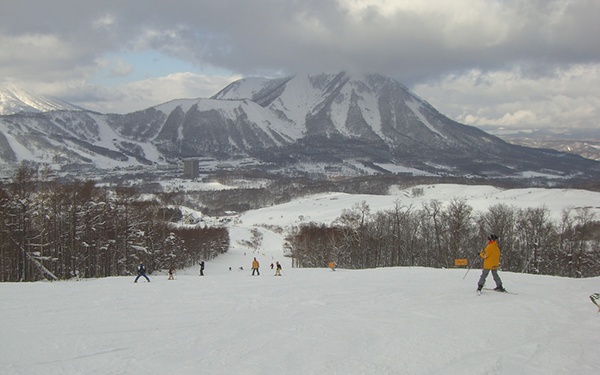
By Jeremy Eades (CC BY-SA 2.0 licence)
Hokkaido is renowned for its epic powder, and with a staggering 512 inches of the light, dry, soft stuff each season Rusutsu has some of the finest snow in the world.
This medium sized resort covers 3 different mountains and has previously been named Japan’s best ski resort. It boasts a 594 foot vertical drop and 1500 acres of diverse terrain with 37 different trails — as well as some of the best off piste and tree skiing in the country (70% of the terrain is gladed).
This is a friendly resort popular with families, has an excellent ski lift infrastructure, and is suitable for skiers and snowboarders of most abilities.
A dedicated learning area at the base of the mountain is ideal for kids and totals novices, plus lots of scope for strong beginners to spread their wings a little higher up the slopes.
Intermediates advanced skiers will get the maximum out of Rusutsu’s perfectly manicured blue runs, and challenging blacks and double blacks — although for the more advanced and expert skiers the most fun can be had off piste.
The Japanese version of après ski is pretty tame by western standards. At Rusutsu there are 2 hotels at the resort, both of which offer around 30 shops, plus dining and drinking options including both western and Asian specialties.
Staying at the resort is a good way to experience a slice of Japanese culture, and there are some authentic Japanese restaurants both at the base of the mountain in the tiny village and in the resort hotels.
There are a few lively little izakaya style bars in the village, and there are more upmarket cocktail bars at the resort, as well as a lively sports bar.
Nozawa Onsen
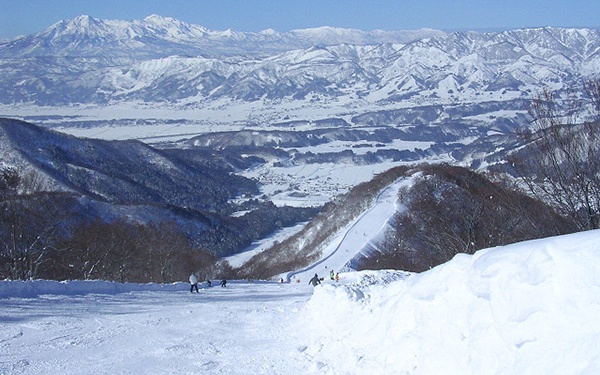
By E-190 (CC BY-SA 3.0 licence)
One of Japan’s oldest, largest, and most popular ski resorts, Nozawa Onsen has been enticing skiers to its slopes since 1912 is considered by many to be the birthplace of skiing in Japan.
This characterful and historic ski resort boasts the largest ski area in Japan, with around 298 hectares with 50 runs, and guaranteed snowfall with an average of over 390 inches quality snowfall each season. The resort extends from the top to the foot of Mount Kenashi and has a vertical drop of 1085 meters.
The 50 km of slopes are serviced by 20 lifts including the 3.5km long Nagasaka Gondola. Nozawa Onsen has runs for all skiers and snowboarders of all levels to enjoy.
Beginners will have a ball at the 3 large areas dedicated to novices at the 3 mountain bases, and the 40% beginner trails include some excellent long runs such as the wide 2 km long Uenotaira run on the upper part of the mountain, and the glorious 5 km run tree lined Rinkan course — although this can get crowded at times.
30% of trails are designated orange, and intermediates have the choice of some good trails at the top of the mountain offering amazing vistas of the Japanese Alps, while more advanced skiers can benefit from some challenging moguls and steep pitched trails, and a vast amount of excellent off piste terrain, with chutes, steeps and cliffs, and glade skiing.
Nozawa Onsen is just as famous for its traditional and lively ski town as for its skiing terrain.
Not only does it have a wide range of bars and restaurants compared to most other ski resorts in Japan, it also lays claim to numerous hot spring bath houses (onsens) — a uniquely Japanese experience not to be missed.
Public bath houses are free, and offer the chance to soak sore muscles in soothing naturally heated, mineral rich waters.
There are no big hotels here, just charming Japanese guest houses — many of which have their own private onsens.
The restaurants here offer a range of excellent cuisines, including Japanese, Italian, and European, but it’s the Japanese fare which is truly delicious. Several bars offer a choice of entertainment options, from karaoke to dancing, to just drinking. Popular après spots include Stay Bar which has a daily happy hour and plays cool tunes, and Himatsuri, and upscale izakaya bar.
Appi Kogen
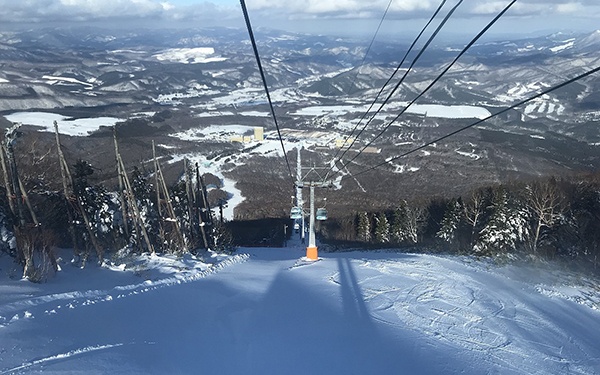
By Inazo1862 (CC BY-SA 4.0 licence)
Often considered as Japan’s answer to St Moritz or Aspen, Appi Kogen really is guaranteed to make you ‘appi’. A purpose built ski resort in the northern part of the island of Honshu, services and facilities here are to a very high standard, with a seamless infrastructure of 18 lifts and perfectly groomed runs.
The snow here is ideal with 315 inches falling each year on average, and the 282 hectares of terrain spread over the mountains of Mount Maemori and Mount Nishimori feature a 828 foot vertical.
Trails are split into 30% beginner, 40% intermediate, and 30% advanced, and offer a large variety of wide, long ski courses, including groomed and ungroomed runs and mogul terrain.
The novice terrain here is particularly great, with an ideal pitch and good possibilities for progression – although some beginner trails are a little trickier to access. Confident beginners and intermediates will have tons of fun in the dedicated areas for novice mogul skiers, and advanced snowboarders and skiers can get their thrills on some steep blacks and ungroomed runs, as well as back country tree skiing.
Popular with westerners, at least some English is spoken in most places around the resort, and when it comes to food there are a wide variety of quality restaurants with English written menus to choose from, including those at the Appi Grand Hotel, which dish up a smorgasbord of tasty options such as Japanese, Korean BBQ, French, Chinese, and more.
Nightlife at Appi is pretty calm, but for a little après wind down, Sassari puts on a daily happy hour for beers and cocktails, and there are a few other bars and karaoke joints which stay open until around midnight.
Best Ski Resorts in Andorra
Grandvalira
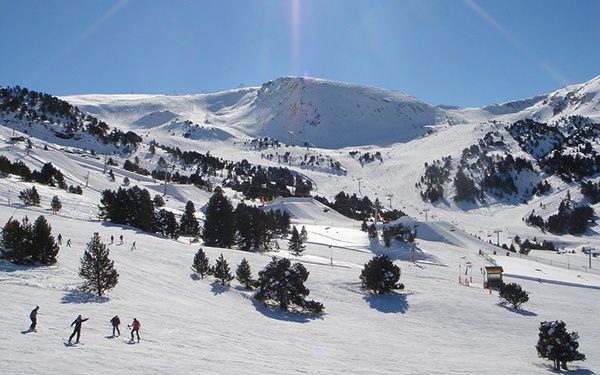
By Christof Damian (CC BY-SA 2.0 licence)
The world class Grandvalira Ski Resort features 210 km of runs, a vertical drop of 3051 feet, and 216 inches average seasonal snowfall.
Created by merging together the three smaller ski resorts of Soldeu, El Tarter and Pas de la Casa, Grandvalira is the largest ski resort in the Pyrenees and the south of Europe, and one of the 30 largest ski resorts in the world.
There are 6 different, interconnected base villages which range in terms of terrain and facilities available, and Andorra’s capital Andorra la Vella is also just next door.
66 lifts including high speed quads, gondolas and chairlifts provide access to the 128 runs, which are split into 16% beginner, 38% intermediate, 30% advanced, and 17% expert.
Beginners can ski all 6 areas, with dedicated novice areas, wide slopes, easy valley runs, and some great ski schools. There are mellow intermediate trails, and the areas around Pas de la Casa and Grau Roig offer up 200km terrain best suited to intermediates.
Experts and freeriders can enjoy an abundance of black slopes, many with deep snow or moguls, as well as high level cross country skiing.
There are also 4 incredible world class snow parks and a freestyle academy, which are designed to bring together all freestyle lovers so they can learn, use and develop their tricks.
There’s a plethora of après ski fun to be had at Granvalira, at a choice of locations. The hottest spot is Pas de la Casa, where some of the highlights include happy hour and live DJs on the terrace at Coll Blanc, the popular Paddy’s Irish bar with live music, cheap eats, and pool tables, Olimpiades Restaurant & Snack Bar also with live music, DJs, an outdoor covered and heated terrace and delicious home cooked food, and the Underground Bar — open until the early hours for dancing, live music, and karaoke.
There are also some great entertainments and nightlife on offer in Soldeu and El Tartar. Foodies are sure to find something to please amongst the 40 eateries and restaurants both on the slopes and in the base villages — many with outstanding views.
Some of the most highly recommended include the Restaurant Racó de Solanelles serving up traditional Andorran cuisine to a breathtaking mountain backdrop, the unique Iglú Hotel entirely built from snow at 2350 meters altitude, and Steak House Gall de Bosc where you can tuck into gourmet meaty fare accompanied by a wild west show.
Ordino Arcalis
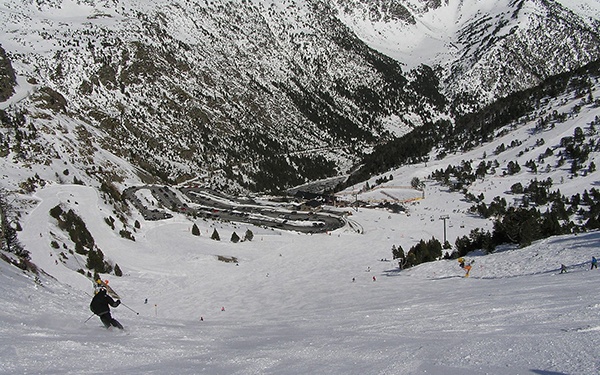
By Terence wiki (CC BY-SA 3.0 licence)
Andorra’s smallest ski resort with 442 hectares nonetheless boasts some fantastic freeride terrain and exceptional quality snow with a seasonal average of 230 inches snowfall.
The vertical drop is 2280 feet, with 15 ultra modern lifts servicing the 27 runs which total 30km of piste, divided into 33% greens, 22% blues, 37% reds, and 7% blacks — and all within a perfectly preserved natural landscape.
The longest green slope in the Pyrenees can be found here, which is great for families and beginners, and there are excellent learning facilities for children. There’s varied terrain here for all levels of ability, If you fancy a challenge, there are two steep black marked runs and five FIS slalom courses in the ski area, or just take your pick from one of the many sweet red or blue runs.
Crowned a mecca for freeriders and freestylers, the resort has some of the gnarliest terrain and challenging off piste around, plus a spectacular 15000m snowboarding park.
Après-ski is fairly calm at Ordino Arcalís ski resort, but there are a couple of bars for drinks. Most of the post ski fun happens away from the slopes at the nearby village of Ordino, where there are a few friendly but quiet bars and some restaurants.
For quality food with a view, hop on a sledge up to the Borda de la Coma restaurant to enjoy a fantastic fondues or T-bone steaks under the stars.
Pal Arinsal
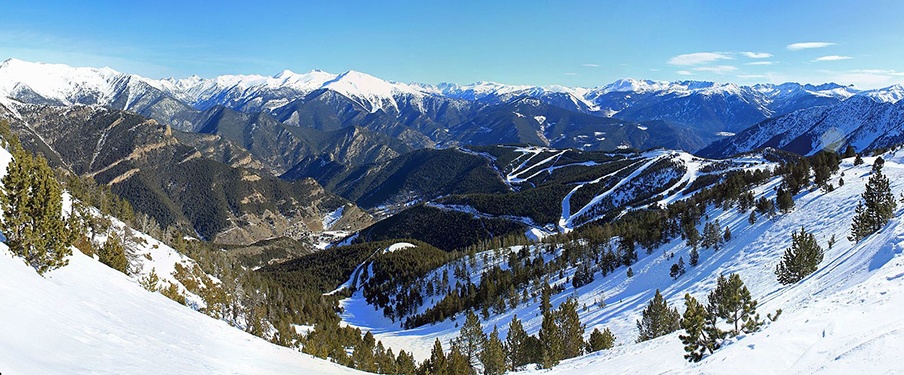
By Michael Karavanov (CC BY-SA 3.0 licence)
The ski area at Arinsal sits below the highest peak in Andorra, Pic de Coma Pedrosa at a height of 2943m, and is connected to the Pal ski area by a 50 person cable car.
Combined, the two areas offer 63 kilometres of excellent and varied skiable terrain over 770 hectares, with a 3314 foot vertical, and around 150 inches average snowfall plus additional snowmaking.
30 lifts take skiers and snowboarders 2560 meters up to enjoy the 42 runs of which 7 greens and 15 blues are ideal for beginners, being wide and easily manageable.
For the more confident skier, there are advanced blues and 16 red runs which include some steep sections. It’s also possible to complete a satisfying circuit across the two peaks — Pic del Cubil and Pic D’Enclar. There’s less to suit experts here, but the 5 black runs have some demanding descents, and there are also 4 off piste free ride zones perfect for getting some thrills.
There’s some spirited nightlife at Pal Arinsal ski resort, with both the towns of Pal and Arinsal touting some great bars and clubs for après ski fun.
The more popular place to party is the friendly town of Arinsal where more than 24 bars are open for drinks, live music and DJs until late, and certain bars such as El Cau have a dance floor and sometimes feature live performances such as wrestling matches.
When it comes to food, you won’t be disappointed. Try some mouthwatering local Catalan cuisine, or get your chops round Mexican, Thai, Chinese, or British fare.
Arinsal is also the closest ski village to the capital Andorra La Vella, where you will find a state of the art spa, some great places to shop, and even more restaurants and bars.
Best Ski Resorts in Canada
Whistler
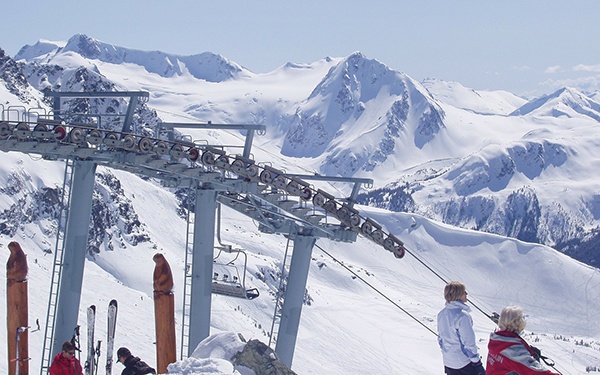
Canada’s largest ski resort is made up of both the Whistler and Blackcomb mountains to provide a vast 8000 acres of awesome skiable terrain coupled with outstanding views.
This resort receives a lot of snow, with more than 432 inches seasonal average, and boasts an impressive 5279 foot vertical. Slopes are extremely well serviced by numerous modern lifts including gondolas and high speed quads.
Of Whistler’s 234 runs, 18% of them are well suited to beginners — particularly those on Whistler mountain. Intermediates are spoilt for choice, with 55% of runs designated blue and all of which have stunning views.
There are alpine bowls, glaciers, and include the iconic seven mile long Peak to Creek run which travels all the way to the Creekside Village, taking in the entire 5000 foot vertical.
Advanced and expert skiers are blessed with 27% black runs including some double diamonds with chutes and cliffs, and extensive backcountry terrain which even offers up cat and heliskiing.
8 terrain parks covering 100 acres complete with Olympic sized super pipe will satisfy any freestyler.
The ski and snowboard schools on Blackcomb are well known for their high quality, adding to the appeal of the resort to families, but there really is something for everyone here at Whistler, however it can get crowded at times — particularly on Blackcomb mountain.
Take a look at what Whistler has to offer in this video:
World famous Whistler is top notch when it comes to après ski. No matter what your budget, the cosmopolitan Whistler Village has lots to offer.
The resort nightlife is buzzing but stays friendly, and there are plenty of venues suitable for families. Wind down after a days skiing with a cocktail at base camp before heading to one of the numerous bars and clubs in town. No matter what your preference there are establishments to suit — from classy lounge bars to late night clubs spinning the latest tunes.
Equally, when it comes to dining options there is everything you could wish for at Whistler, from elegant top end restaurants to fast and filling food such as burgers and pizza.
If you’re looking for other activities to fill your downtime there are regular concerts held in the village, as well as a world class spa and snow based pursuits including dog sledding and tubing.
Big White
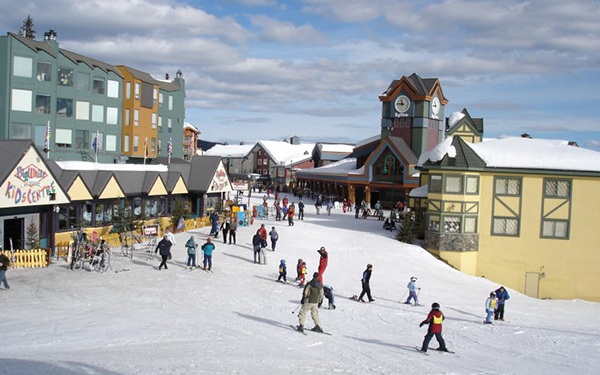
By claire rowland (CC BY 2.0 licence)
Big White Mountain in British Columbia, Canada is favored with nearly 300 inches of champagne powder each season, dishing up ideal terrain of more than 2,655 acres with a 2549 vertical for snow hungry skiers and snowboarders to sink their teeth into.
Big White’s 118 scenic runs are legendary, giving up awesome terrain including steeps, long groomers, moguls, tree runs, alpine bowls and more — all serviced by 16 modern ski lifts.
With 18% beginner, 54% intermediate, 22% advanced and 6% expert trails there is enough here to keep all levels of ability satisfied. It’s an excellent location for beginners to find their feet and has good progression slopes, and is a popular ski resort with families, with Happy Valley providing numerous other fun activities for kids to enjoy.
Intermediates have huge amounts to choose from, but expert terrain is slightly limited. That said, Big White’s alpine bowl still poses some worthwhile challenges, and with so much space the resort’s slopes remain relatively uncrowded, although they do get busier on weekends.
The TELUS terrain park provides plenty of scope for freestylers, and comes complete with 3 lanes for different abilities featuring rails, jumps and boxes, plus a competition-ready halfpipe and an Olympic level ski/snowboard cross course.
If all that’s not enough, why not check out some of the other activities on offer including skating at Canada’s highest ice rink, dog sledding, taking a chance on the ice climbing wall, snowmobiling, and snowshoeing.
There’s a great restaurant and bar scene at Big White Village, with the added advantage of ski in / ski out access to the slopes. While the village isn’t the biggest there are lots of cool, friendly eating and drinking venues for families, couples, singles and groups. With pool tables, live music, and craft beers, Snowshoe Sam’s Pub is a popular spot for getting the après off to a flying start, and for late night fun take the party over to Sessions Taphouse with its brewery and a dance floor staying open into the early hours.
More than 20 restaurants are available to gratify your belly when it begins to growl, such as the Globe Cafe & Tapas Bar with uniquely creative cuisine and regular evening entertainments, and Italian and Mediterranean fine dining at the 6 Degrees Bistro in Stonebridge Lodge. Alternatively there are a wide range of steakhouses, pizza places and more.
Sun Peaks
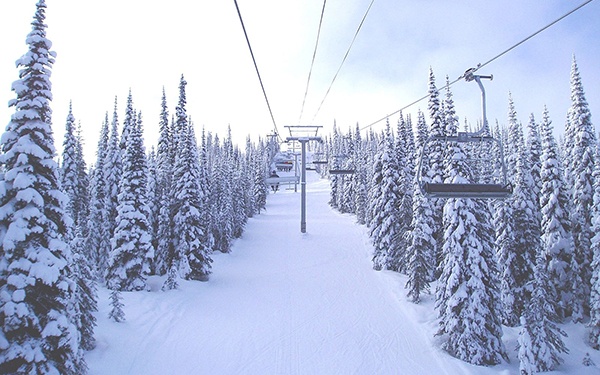
By Janet Hopkins (CC BY 3.0 licence)
Renowned for it’s world class ski school, Sun Peak ski resort is also the second largest in British Columbia, with 4,270 acres of skiable terrain, a 2894 foot vertical, and 236 inches annual average seasonal snowfall giving it plenty of appeal to families and to skiers and snowboarders of all levels.
The 135 runs are dotted across three different mountains, but the infrastructure is to a high standard with 13 lifts and the layout well organized, making it easy to shift between them.
Terrain is split into 10% beginner, 58% intermediate, and 32% advanced and expert, making this an ideal playground for intermediate to advanced skill levels.
Sunny Sundance Mountain with plenty of gentle groomed runs, some steeps, bowls, and tree skiing is particularly well adapted to both beginners and intermediates, while Mount Tod and Mount Morrisey feature more advanced terrain in open bowls, challenging gladed terrain, and long groomers, whilst north facing Mt Morrisey, with some demanding blacks and doubles, glade skiing, chutes and moguls — plus acres of wild off piste.
Novices can cut their teeth at the dedicated beginners area conveniently located next to the ski village, and there are also 31 km of cross country skiing trails to explore.
There’s also a decent terrain park with 100% snowmaking, and the opportunity to take part in other activities including dog sledding, tubing, ice skating, snowshoeing, snowmobiling among others.
The pace of life at the picturesque ski in / ski out Sun Peaks ski village is wonderfully laid back, and very family oriented.
Bars, restaurants, shops and accommodations are painted in cheerful sweet shop shades, but if you’re looking for rowdy nightlife you won’t find it at Sun Peaks. The Club is Sun Peak’s only nightclub — although there is also a late night lounge club in the Delta Sun Peaks Resort — and there are a handful of pleasant bars and pubs for après drinks.
There are currently around 10 restaurants to choose from and a number of cafés. Cuisines on offer range from juicy steaks and burgers through to Canadian classics, and on to Asian and Indian fusion.
>>> Read more: Best 9 Ski Resorts in Canada
Best Ski Resorts in France
Chamonix
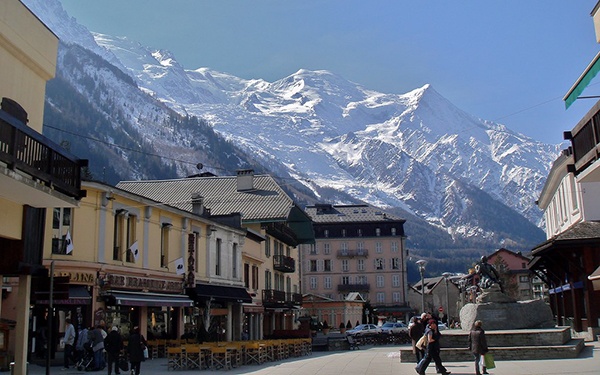
By Patrick Nouhailler (CC BY-SA 2.0 licence)
Something of a holy grail for hardcore skiers and snowboarders, the legendary Chamonix ski resort is infamous for its challenging and somewhat risky terrain.
The views across to neighboring Mont Blanc are awe inspiring, and add to the magic of the resorts’ 300 skiable acres with a vertical drop of 7326 feet.
Chamonix sees on average around 390 inches of snowfall each year, and the slopes have 85 marked runs of which 35% are advanced and 31% expert. With only 5% of runs being suitable for beginners, this is not an ideal resort for novices, but those with a high skill level will get maximum thrills from the extreme terrain full to bursting with spectacular — and often dangerous — off piste and freeriding areas including glaciers, steeps, and tree skiing.
The 12 mile long Aiguille du Midi’s Vallée Blanche is the epitome of extreme glacier skiing with incredible scenery and a vertical of more than 9000 feet, and it’s possible to ski all the way down to Chamonix village by this route.
Strong intermediates should be able to ski nearly all Chamonix’s 11 different ski areas, and it’s the ideal location for them to test themselves and hone their skills.
Runs are well served by 67 lifts — although it’s worth noting that getting between each of the areas can take time and queues can be lengthy.
There are 2 snow parks for freestylers of all abilities to strut their stuff, and in January Chamonix hosts a leg of the Freeride World Tour, when the worlds best freeride skiers and snowboarders come to compete.
Elegant and glamorous, the historic town of Chamonix is home to a dazzling array of boutiques, cafes, bars, and restaurants, and it’s the heart après.
The epic nightlife on offer includes bars such as Chambre Neuf with live music and table dancing, the Monkey Bar with its inviting sun terrace, happy hour and DJs, and L’Amnesia nightclub – the best of Chamonix’s late night venues which regularly hosts internationally renowned DJs.
Gastronomes will delight in the fact that Chamonix town is home to the one of the only two restaurants in the Alpsto have been awarded two Michelin stars — Restaurant Albert 1er — which specializes in modern French cuisine inspired by Mont-Blanc and the Piedmont region of Italy.
If you’re on a budget, then Poco Loco is the place to gorge yourself on delicious burgers, while traditional mountain fare such as fondues, raclettes and tartiflettes can easily be found in many restaurants, in addition to international cuisines including Asian, Mexican, Japanese, Indian, Italian, and Mediterranean.
Les Arcs
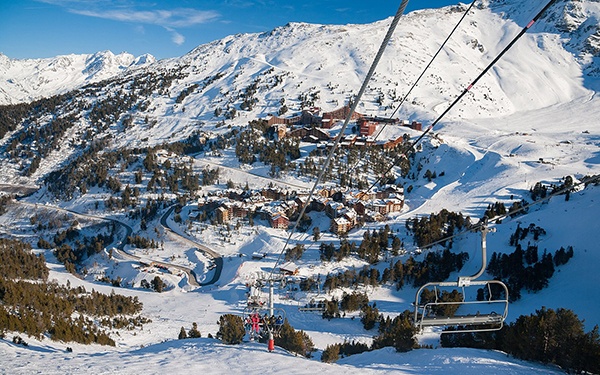
By Dmitry A. Mottl (public domain)
The beautiful Tarentaise Valley in the French département of Savoie is where you will find Les Arcs, rated as one of the best purpose built ski resorts in the world.
This French ski resort has everything you could possibly need or want from a winter sports vacation. The huge interlinked, snow sure ski area covers 1280 acres and has a 6647 foot vertical, a high speed lift network, and 128 marked runs, as well as stunning scenery.
While only 2% of runs are beginner, the resort’s ski schools have a reputation for excellence, and there is in fact lots of suitable terrain available on the lower slopes to those starting out, and plenty of terrain for families.
With nearly 50% of runs being green or blue, Les Arcs has lots to offer intermediate skiers and snowboarders, including copious long, groomed trails, alpine bowls, and huge powder fields, whilst higher up the mountain there are enough super steep runs, moguls, cliff drop and chutes to satisfy any expert, as well as some incredible off piste action.
Take a look at Les Arcs in action:
The relatively quiet Les Arcs Apocalypse Snow Park is equipped with good size kickers, tabletops, rails and jumps, plus a couple of half pipes. In the event that you want to take a break from the fabulous skiing at Les Arcs, there are oodles of other activities available, including ice skating, paragliding, snowmobiling and dog sledding.
Four contemporary villages make up the resort — all of which have direct ski in / ski out access to the slopes, and all of which are interconnected by a shuttle service which makes it easy to hop between them.
All 4 villages have plenty of entertainments on offer in the form of bars, restaurants, spa and wellness centers, supermarkets and boutiques.
The Arc 1800 village (named for its altitude) is particularly popular with families owing to its state of the art entertainment complex complete which boasts an aquatic centre, cinema, bowling alley, snow play areas, and toboggan run.
It’s also where it’s at for some kicking après, with everything from laid back lounge bars to strip joints.
The range of restaurants in the villages is excellent, from traditional French, to crowd pleasing pizza, to fine dining with excellent wines at establishments such as La Table de Lys.
Val d’Isère-Tignes
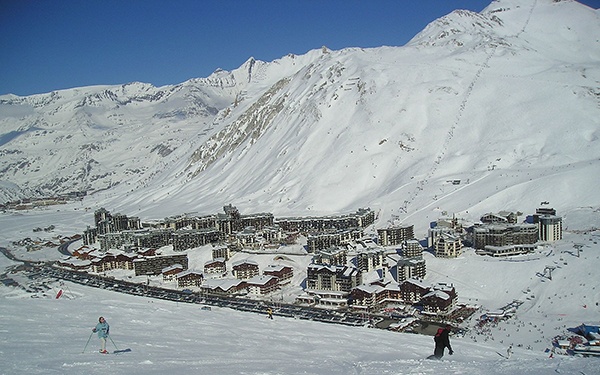
By Tonkie (CC BY-SA 3.0 licence)
Also in the Tarentaise valley lies France’s third biggest ski area — and some would say the ultimate ski resort — Val d’Isère-Tignes, one of the most beautiful and extensive ski domains in the Savoie region and in the Alps.
Comprising 300km of world class, snow sure skiing terrain with a 6234 vertical drop, Val d’Isère-Tignes has more than 140 marked runs serviced by 102 ski lifts, split into 8% beginner, 44% intermediate, 27% advanced, and 21% expert.
There are 3 main ski areas offering skiing and snowboarding for all abilities.
The Grande Motte glacier at 3456m altitude is one of the resort’s undeniable highlights, offering some supreme descents both on and off piste, including a blissfully long but strenuous red run with a 1350 meter vertical, and the Glacier de Pissaillas features green, blue, and red pistes at a height of 3450 metres, as well as both on and of piste descents with a 1500 meter vertical down into Le Fornet village.
The Solaise ski area has some of the best intermediate terrain, whilst the Bellevarde ski area is the biggest due to its diverse terrain being suited to all skill levels, and there are almost limitless free-riding, off piste skiing, and snowboarding opportunities throughout the resort.
In addition to the legendary ski terrain there is a world class snowpark featuring tables, rails and jumps to please all levels of skill.
The villages of Val d’Isère and Tignes are distincly different, but both have their charms. Modern Tignes is a hub for hardcore skiers and snowboarders, and après-ski entertainments are thinner on the ground than the quaint village of Val d’Isère, which is dotted with fine architecture and ancient chalets.
Fashionable Val d’Isère is something of an après hotspot, with festivities starting on the slopes – notably at the famous Folie Douce with its terrace, live music and DJs — and continuing in one of the many chic bars, boisterous pubs, or glitzy nightclubs in town.
The British bars are particularly popular, but other top hangouts include Cocorico known for its live acts and incredible party atmosphere, and Dick’s Tea Bar — one of the biggest and best nightclubs in the Alps.
Hungry? There are a wealth of dining options that mustn’t be missed, whether at the ’Front de Neige’ at the edge of the village, lined with pretty restaurants with sunny terraces, or at one of the multiple fine dining venues including the two Michelin starred L’Atelier Edmond, or La Fruitière where wholesome dishes with a twist are a treat to savour.
>>> Read more: The 10 Best Ski Resorts in France
Best Ski Resorts in Austria
Kitzbuhel
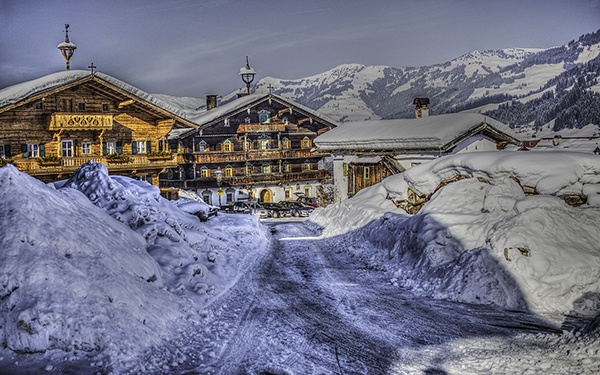
By Valerii Tkachenko (CC BY 2.0 licence)
Consistently ranked among the best ski resorts in the world, Kitzbuhel is for many the perfect Austrian ski experience.
Claiming to be the birthplace of skiing, Kitzbuhel has hosted winter sports events since 1895, including the most famous international race in the Winter World Cup — the white knuckle ‘Der Streif’.
Infamous for its quality terrain, long winters, accessibility, state of the art infrastructure and out of this world après ski, the resort has a total surface area of 1401 skiable acres, with 215km of slopes.
Kitzabuhel’s one drawback is its low altitude, which can have an impact on the amount of snow seen on the mountain, but usually winters are good bringing reliable snowfall, but even when conditions are not ideal there is excellent snowmaking on the lower slopes and it’s still possible to enjoy classic off piste powder skiing and tree skiing.
Intermediates and experts will get the most out of Kitzbuhel, with its 3937 foot vertical drop and 54 ski lifts covering 68 runs, classed as 43% intermediate, 40% advanced, and 18% expert.
Awesome red and blue runs can be found off pretty much every lift here, and there are high alpine runs, groomed cruisers, and steep wooden terrain.
Experts will find enough to keep them happy for a few days here, including some nice long black runs plus some easily accessible freeride spots and an awesome snowpark, but Kitzbuhel is not ideal for beginners.
You don’t get more quintessentially Austrian than the Tyrolean Kitzbuhel town. This glorious medieval town has its roots in silver mining, and everywhere you look there is beautiful historic architecture. Modern Kitzbuhel is bursting with glamour and glitz, with high end boutiques, bars, cafés, and restaurants, frequented by chic clientele.
When it comes to après ski it is Austria’s undeniable Don. The party vibe is in full power here and things can get pretty lively – particularly at weekends. The Londoner is one of the most popular bars among revelers, who come to get a bit crazy, get drunk, and dance on tables. There are a whole host of other bars and clubs to keep the party going, including the stylish Club Take 5 with top notch DJs, cocktails and champagne, and a VIP area.
As you would expect from such a well heeled ski resort, the dining options are also fabulous. There are over 100 restaurants to choose from both on and off the mountain, ranging from eateries serving simple fare such as pasta and pizza, through traditional Tyrolean, to decadent gourmet delights at award winning restaurants like the triple Gault Millau toque winning Kupferstube in the five star Hotel Tennerhof.
St Anton
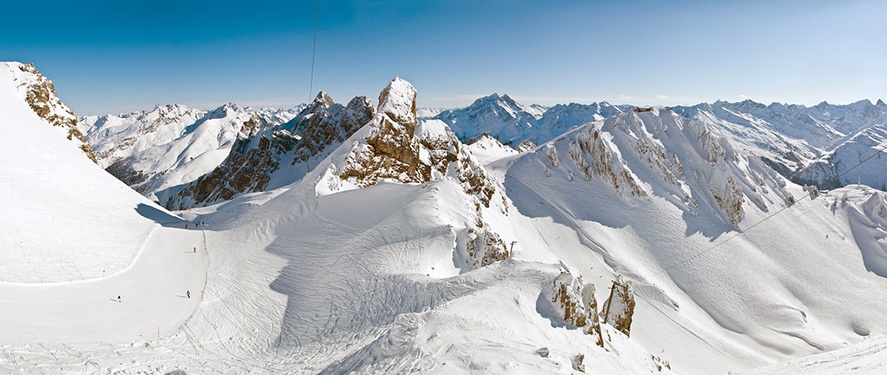
By Colin Capelle (CC BY 2.0 licence)
Not only does St Anton ski resort have some of the most gnarly slopes around, it is also exceptionally beautiful.
With around 1102 skiable acres, 340 km of piste, and more than 200 km of backcountry terrain it is Austria’s largest ski resort, and boasts a 5000 foot vertical and around 275 inches seasonal snowfall.
Of the 141 runs served by a whopping 94 lifts, 52% are blues, 35% reds, and 13% expert. The steep black runs plus the vast amount of extreme off piste terrain full of moguls, tree skiing, cliffs, and chutes is more than enough to keep expert skiers and snowboarders begging for more, while at intermediate and advanced level there are speedy reds and challenging blue runs, with the Rendl ski area offering up some of the best intermediate terrain and more reliable snow conditions.
There is less on offer for beginners apart from a few fairly demanding nursery slopes, but the ski school has an excellent reputation. This is a popular resort, and the slopes can get busy at peak times, so be prepared to form an orderly queue at the ski lifts.
The Stanton terrain park features freestyle perfect kickers, rails, boxes and jumps for all levels of skill.
If you come to St Anton looking for fun, you won’t be disappointed. The après here is world famous, from St Anton village with its buzzing bar and restaurant scene, to lively rustic ski huts on the mountain.
The cult MooserWirt bar on the mountain is a notoriously fun, rowdy après hotspot with live music where drinking, singing and table dancing are actively encouraged, and there are an abundance of other fantastic bars where you can enjoy the views on a sunny terrace and let loose after a day on the slopes.
If you want to party hard, the Kandahar bar offers a delicious Asian menu and is open until 6am, or alternatively try Post Keller where DJs pump out tunes into the early hours.
Unconvinced? Take a look at this video for more St Anton apres…
There are a wide choice of restaurants — more than 70 in fact — dishing up all kinds of cuisine including traditional Austrian, Mexican, Indian, Thai, burgers, pizzas and seafood, and gourmet fine dining options.
Saalbach
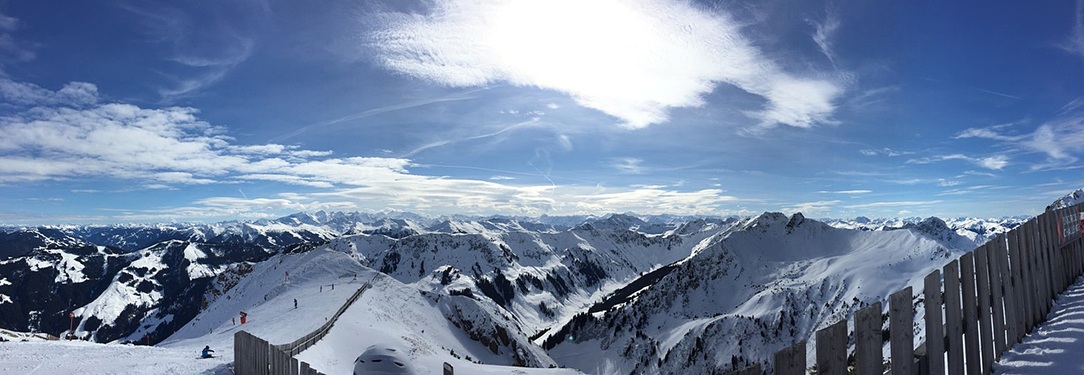
Saalbach — aka Skicircus Saalbach — in Austria’s Salzburgerland province has a friendly, laid back vibe which makes it a pleasure to ski there, and also provides 409 hectares of awesome terrain with a 4282 foot vertical spread out over 5 valleys, offering masses of fun to be had for all levels of ability — but especially those with intermediate and advanced skills.
With nearly 200 inches of snow falling each season on average, conditions are pretty good, but there is also solid back up from an extensive snowmaking system if the natural snow isn’t quite up to par.
The 270 km of piste boasts 105 runs well connected by 70 lifts (of which nearly 30 are gondolas), and are roughly split up into 50% beginner / intermediate, 40% advanced, and 10% expert.
For learners and kids there are some good novice areas close to the two resort villages, but it’s the huge wealth of sublime blue and red runs for intermediate to advanced level skiers where Saalbach really comes into its own, with long, groomed cruisers, steep trails, and fantastic off piste complete with powdery alpine bowls and tree skiing.
Quite simply, Saalbach is paradise when it comes to the reds and blues. There are 5 snowparks at the resort, with the Night Park in Hinterglemm offering up the most interesting freeride fun, with 3 different lines for different levels of ability.
Alongside the bars and restaurants on the mountain, the two traditional ski villages of Saalbach and Hinterglemm provide endless opportunities for quality après mischief and mayhem.
In all there are over 60 bars and clubs offering entertainment, with live bands and DJs, a constant flow of alcohol, and an amazing fun filled atmosphere.
Among the most well known hangouts are Berger Alm with outdoor terrace, live music, and late afternoon happy hour, and the glitzy Castello club at the Saalbacherhof Hotel for late night frolics.
When you’ve worked up an appetite there are a ton of restaurants and eateries where you can eat your fill. There are over 70 places to eat at the resort, including upscale hotel restaurants, cosy cafes on the mountain and fast food establishments.
A notable highlight is the top notch Austrian cuisine at Wieseralm — a charming wooden hut high on the mountain with a sun soaked panoramic terrace.
>>> Read more: The 11 Best Ski Resorts in Austria
Best Ski Resorts in Switzerland
St Moritz
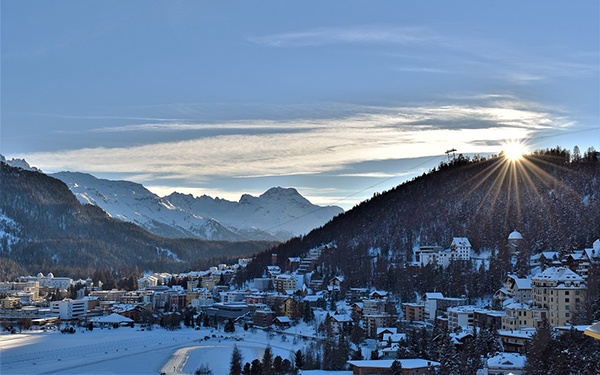
No list of the best countries in the world for skiing would be complete without St Moritz. This prestigious ski resort has long been a playground for the jet set, and as such is a little on the expensive side, however there’s a whole lot more to St Moritz than just a glamorous facade.
This top Swiss ski resort can justifiably brag about its 350km of pistes spread out over 3 large ski areas – Corviglia, Corvatsch, and Diavolezza Lagalb — each of which features unique different, diverse terrain and all of which benefit from between 315 to 394 inches average seasonal snowfall.
All three areas combined offer a total of 308 marked runs suitable for different levels of ability, with the overall division being about 18% beginner, 62% intermediate, and 20% advanced.
There are 42 lifts including 10 gondolas serving the pistes. The Corviglia area boasts gorgeously sunny south facing slopes with an abundance of red runs and a 4354 foot vertical drop.
Here intermediate and advanced skiers can enjoy long, perfectly groomed pistes, as well as challenging steeps, alpine bowls, and chutes, and there are also some excellent facilities here for those learning to ski. North facing Corvatsch features a 4941 foot vertical drop, and hands out another happy dose of incredible intermediate terrain along with unsurpassed views, glacier skiing, top quality snow, and awesome freeriding.
Lastly, the two mountains that make up the Diavolezza Lagalb ski area is off piste heaven, with amazing backcountry to explore and endless acres of powder to make more accomplished and confident skiers and snowboarders drool with delight.
In addition to all of this there is an extensive network of cross country trails covering more than 230 km, and St Moritz’ frozen lakes open up plenty of other opportunities for winter activities.
Vibrant nightlife, parties on the slopes, elegant cocktail bars, people watching, casinos, world class DJs, luxurious restaurants, designer boutiques… the après at St Moritz alone attracts masses of people each year.
There are around 30 bars, most of which are pretty upmarket, and the hottest ticket in town is the sophisticated King’s Club nightclub with a sharp dress code and world famous DJs.
It’s also a great place for celebrity spotting. St Moritz ski resort has more than 70 restaurants both on and off mountain, many of which are of exceptional quality but with price tags to match. there are however some good standard options available including pizza and pasta, and BBQ grills.
If you’ve got the cash to splash the highly rated Restaurant Chasellas in the centre of town puts on lavish gourmet evening feasts of French cuisine with an international touch.
Engelberg
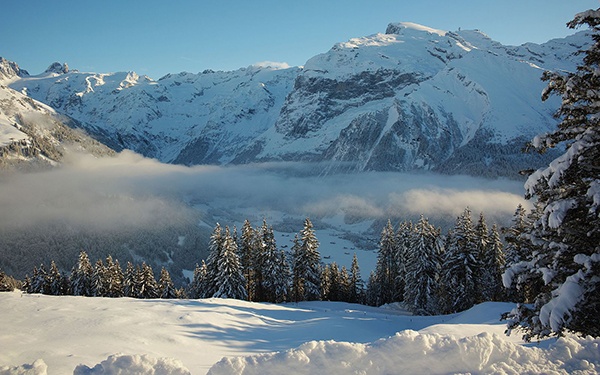
By Gestumblindi (CC BY 23.0 licence)
One for the true powderhounds, Engelberg is well known for its regular fresh, storm driven snow dumps and electrifying 6560 foot vertical descents.
There’s an immense amount of intense, deep snow, off piste freeride terrain here for advanced skiers, capped by the mighty Titlis glacier, as well as a good selection of red and blue runs on piste with a few mogulled blacks thrown in.
The classic Laub run is one of 5 impressive descents with a consistently steep 3280 foot vertical which offers impressive views. Ski touring and backcountry skiing are available to the adventurous, but require a guide.
There are 25 km of blue runs for beginners, but this is really a destination for the more skilled skier. There are 28 ski lifts at Engelberg, some more modern than others, but the infrastructure is not ideal and some trails can take time to reach.
A decent terrain park with numerous jumps, rails, a half pipe and a quarter pipe, and facilities are regularly upgraded.
Engelberg village is relatively calm and modest, although things tend to get a lively boost at weekends. That said, it is also surprisingly cosmopolitan and there are a good choice of restaurants and cool bars awaiting skiers looking for après ski entertainment.
In town, Mexican themed Yucatan is arguably Engelberg’s biggest and best bar, while at the base of the slopes The Chalet gets buzzing by afternoon when the ski lifts shut up shop. The Spindle is the place to be for late night partying.
When it comes to food, take your pick from cozy eateries dishing up Swiss specialties on the mountainside, or Asian, Italian, or European restaurants in town.
Verbier
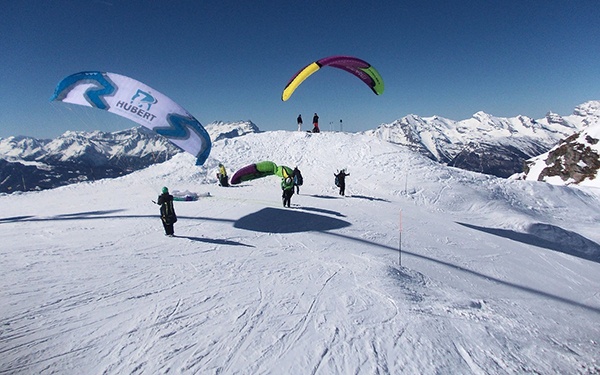
Encompassing the entire westernmost side of the gigantic 4 Vallees ski region, Verbier ski resort is one of the largest ski areas in Europe, with 400 acres of skiable terrain in magnificent scenic surroundings with views across to the Matterhorn and Mont Blanc, plus reliable snow cover to the tune of 331 inches average seasonal snowfall and a sensational 6004 foot vertical.
82 lifts take skiers and snowboarders to the top of the 94 runs which make up over 410 km in total – and there is also a huge amount of lift served off piste terrain.
Everybody will find trails to suit at Verbier, although there is less for novices and the beginner slopes are set a little out of the way, with little room for easy progression.
The mellow, sun kissed bowl of La Chaux is a popular spot for families and those getting their feet. For intermediate to expert there are thrills aplenty to be had here.
The 31% blue runs and 48% red runs are ideal for adventurous intermediate and advanced skiers, however they can get crowded.
However Verbier’s biggest attraction is the fantastic off piste terrain, guaranteed to get the adrenaline pumping.
Cliffs, chutes, moguls, steep couloirs and more await to challenge the most confident of skiers, but be aware that the yellow off piste trails are not patrolled and not without risk, and venturing away from them should only be done when accompanied by a guide.
The outstanding Verbier Snowpark is the venue for many Big Air competitions, and features rails, jumps and boarder cross for all levels, as well as plans for a half-pipe.
Verbier attracts an enthusiastic, fun loving crowd, and although the resort town is small, there’s lots of merriment to be had.
Après kicks off on the mountain, where hip bars like Ice Cube and Le Mouton Noir pull in the crowds with the temptations of happy hour cocktails, sunny terraces with panoramic views, and live DJs, but when the slopes close the party is focused around Place Centrale in town, which is lined with lively bars and restaurants pumping out tunes.
Whatever your stomach desires, you will probably find something to please it at Verbier ski resort, whether that’s a succulent burger, pizza, sushi, or elegant French inspired fine dining.
Best Ski Resorts in Norway
Hemsedal

By Siri (CC BY-SA 2.0 licence)
Hemsedal is Scandinavian high altitude skiing at its best. With an average annual snowfall of 118 inches it offers snow sure skiing over more than 44 km of slopes with a vertical drop of 2657 feet.
The 20 modern lifts at this expansive resort take skiers to the start of the 48 pistes which run down from the peaks of the majestic Hallingdal mountains.
With a mix of 46% green, 25% blue, 19% red, and 10% black runs, there is something to please everyone. The abundance of green runs including some long, gentle trails, the largest children’s ski area in Norway plus a wealth of child friendly facilities and activities have made Hemsedal popular with families.
Groomed blue and red runs are plentiful here and make up some of Hemsedal’s longest descents. However for those who like more of a challenge there are two black runs and four often mogulled double blacks which tear down from the top of the mountains into the resort base, as well as a ton of deep snow freeriding fun to be had off piste.
The resort is also an excellent base for cross country skiing and ski touring, and the top class Hemsedal snowpark has got enough lines, rails, and jumps to give even the most experienced snowboarders and freestyle skiers the opportunity to show what they’re made of.
Norwegians like to party, and the folks at the Hemsedal ski village are no exception. During the week things in the village are a little more sedate, but the weekend transforms Hemsedal into a full on party town with some of the best après in Europe.
There are numerous bars, lounges, and nightclubs, including the ski in / ski out Skistua bar with live rock and roll, and the legendary Stavkroa nightclub with a huge dance floor and resident DJs.
There are a good range of restaurants both on and off the slopes, some of which such as the highly rated Skarsnuten Restaurant serve delicious regional specialties, but there are also cafés and delis, burger joints and pizzerias.
Trysil
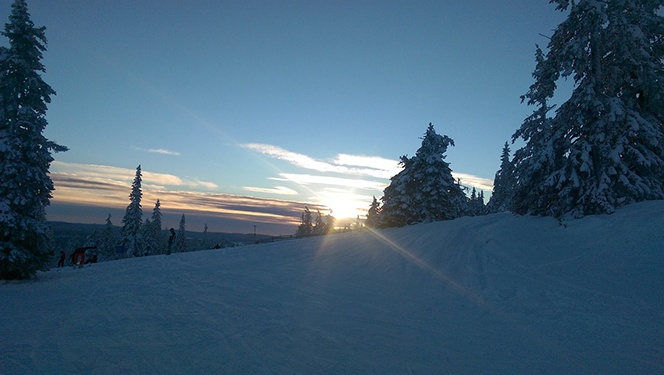
A past winner of ‘best resort in Norway’ at the World Ski Awards, Trysil ski resort packs a lot of punch. This is the largest ski resort in Norway with a 2151 foot vertical drop, constructed on the slopes of Trysil Mountain to afford skiing and snowboarding on all three mountain faces, which are linked by 31 lifts and various slopes.
A trip to Trysil comes with a snow guarantee which means if you’re too short of snow during your vacation, you can either have your money refunded or re-book your trip, although with Trysil’s excellent snow record we doubt you’ll be claiming your money back any time soon.
There are 66 runs in total, which are fairly evenly split between 32% green, 32% blue, 21% red, and 15% black, with a total downhill length of 65 km, and 86 km of cross country trails.
There are some long, challenging black runs for experts, some of which are sharply pitched and used as training slopes by Olympic skiers.
There’s an extensive network of green slopes which are perfect for beginners, including some nice long sections. For the intermediate and advanced, Trysil’s blue and red runs include wide, long tree lined runs with stunning views that are guaranteed to make you feel the burn.
There’s also some great night skiing to be had here, with some lifts open until 8 or 10pm. Additional entertainments available for kids include 10 pin bowling, and 2 large swimming pools.
Trysil is surprisingly affordable as Norwegian ski resorts go, which when added to the great facilities for kids and beginners has resulted in the resort village catering largely to families.
This means that après ski tends to be calmer than some other Norwegian ski resorts, but there are still lots of opportunities to have fun.
Popular après bars such as Stabben and Ski Pub’n have a relaxed, cozy vibe with live music, drinks and food on offer, while the buzzing Restaurant Laaven 1790 is a little more rowdy with table dancing, and late on Saturdays, it turns in to a full blown nightclub.
There are lots of friendly restaurants open for lunch and dinner, dishing up treats like waffles, pizzas and burgers, salads, sushi and more, plus atmospheric mountain restaurants serving traditional dishes such as goulash and local cured meats and fish.
Geilo
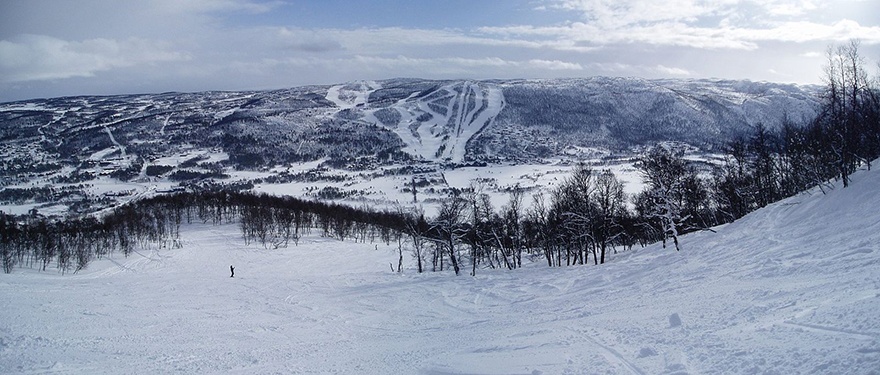
By dokaspar (CC BY-SA 3.0 licence)
This small, quiet ski resort is often overlooked, but in fact it is a bit of a hidden gem.
As well as offering great skiing and snowboarding, Geilo also has the claim of being one of the world’s best locations for kiteskiing, and is uniquely placed between the sweeping Hardangervidda plains and the gaze of regal Hallingskarvet and Hardangervidda mountains.
It’s ideally situated for exploring the surrounding landscape and there are 220km of well maintained and marked cross-country tracks, some of which are lit up at night for evening excursions. 32 kilometers of slopes provide 40 runs, many of which are perfectly groomed.
Geilo is ideal for children, families, and novices alike, as 27% of runs are green, its top quality ski school, dedicated areas for kids, regular events, childcare facilities, and its compact nature which is easy to navigate.
The remaining runs are allotted as 32% intermediate, 30% advanced, and 11% expert, so there’s plenty of scope for all skill levels to enjoy this top Norway ski resort.
The charming and friendly village has around 40 shops and boutiques, and numerous bars and restaurants, many of which are based in hotels and are the focus of Geilo’s après-ski scene.
Being such a family oriented ski resort, things rarely get rowdy, but at Havsdalskroa après starts early and there are late night venues where you can drink and dance to your heart’s content, as well as enjoying some of the mountain’s best pizza.
There are a handful of other cafes and eateries on the slopes, serving quality, hearty food.
Best Ski Resorts in Slovenia
Mariborsko Pohorje
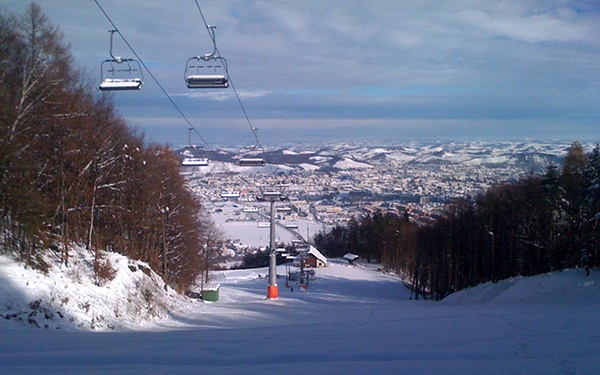
By breki74 (CC BY-SA 2.0 licence)
The biggest ski resort in Slovenia is also the sunniest, with 73 sunny days on average per season. Picturesque Mariborsko Pohorje is located on the main crest of Pohorje Mountains, surrounded by lush forest.
In February this year it hosted the FIS Ski World Cup, and The ‘Golden Fox’ race in the Women’s World Cup is an annual event. It’s easy to see why these events are held here.
The resort experiences sure natural snowfall over its 250 hectares of skiable terrain, with a vertical drop of 3287 feet. 64 km of trails are available, with the majority of the 25 runs (57%) being blues suitable for beginners and intermediates.
Of the rest, 31% are red, and 12% black, and experts shouldn’t pass up testing their skills on the FIS slalom course.
Split into two main areas linked by 2 of the 21 ski lifts, there are ski and snowboarding schools and a ski kindergarten on site, as well as good access to cross country trails and 10 km of floodlit runs for night skiing until 9 pm — the longest night skiing trail in Slovenia.
As well as pretty decent ski slopes, there is a first class spa and wellness center at the resort, and the location is within easy reach of Maribor, the second biggest city in Slovenia.
The Koca Koca Lodge at the next to the Pohorska Vzpenjaca ski lift is the place to be for après-ski entertainment, but for a choice of bars, clubs and restaurants it’s necessary to make the short trip into nearby Maribor city.
Kranjska Gora
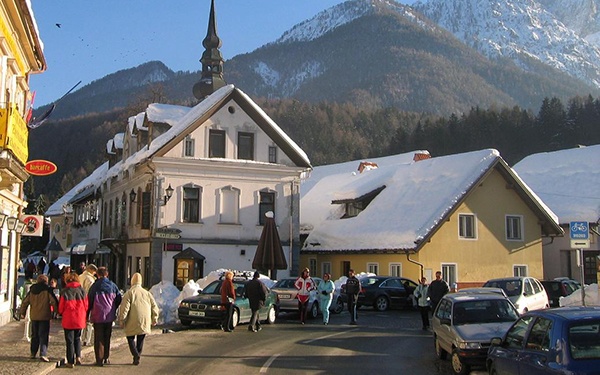
By Ziga (public domain)
In Slovenia’s northwest, not far from the borders of Italy and Austria, Kranjska Gora ski resort lies in a pretty valley in the wooded mountains between the Julian Alps and the Karavanke.
Good snow conditions are likely, but not guaranteed at this small but scenic resort, but there is full snowmaking coverage, and it has been awarded the title of best value family ski resort in Europe, and it’s an extremely affordable ski and snowboard destination.
Kranjska Gora is a fantastic place to learn to ski, with excellent beginner facilities and centrally placed nursery slopes, in addition to around 60% of the 17 runs being green or blue and ideal for novices and lower intermediates.
30% of the runs are red, but are a little limited, and of the two expert runs, the Podkoren black run regularly features as a slalom course for World Cup races, and it sure to pose a challenge.
The terrain has a 2493 foot vertical drop, and a total of 19 lifts serve the trails, although they can be a little slow at times.
Away from the slopes there’s also a wide range of other activities to keep everybody entertained, from ice skating to tobogganing.
Some lively après awaits skiers after a day on the slopes at this cozy resort, mainly taking place in the bars and clubs of large hotels.
Popular spots include Vopa Bar which is open until 1 am and hosts live bands, and Pun Legende, an Irish style pub and piano bar with pool tables, karaoke, live music, and a good selection of whiskey and beer.
Dining options are pretty good too, with around 20 restaurants to choose from. Of these, many serve hearty Slovenian cuisine, but you’ll also find pizza, hot dogs, Asian, Mediterranean, and more.
Jasna

Set in a stunning natural landscape on the slopes of Mount Chopok, this top Slovenian ski resort offers amazing value for money, with 49 km of well groomed pistes on 36 slopes served by 28 ski lifts, and a vertical drop of 3481 feet.
When snow conditions are good there’s some terrific off piste with tree runs and challenging, steep terrain which makes for ideal freeriding.
The longest ski slopes in Slovakia can be found here, and the resort hosts the country’s biggest ski events.
Jasna is well suited to intermediates, with half the runs being blue. The rest are mainly fairly challenging reds, and 16% are black.
The Biela Put slope is illuminated for night skiing, and the resort’s terrain park is well kitted out with a good selection of boxes, rails, tunnels, and varied jumps.
Other activities are limited on the mountain, but the nearby town of Liptovsky Mikulas has a whole host of entertainments for families and adults, such as karting, a cinema, a huge aquapark, bowling, and a spa and wellness center.
Likewise, there are lots of bars, clubs and restaurants in Liptovsky so you’ll probably want to head there for an evening out.
For afternoon après ski though, the Happy End bar at the resort is a decent venue open until 5 pm during the week, but staying open until late at weekends with DJs, live bands, and regular events.
Best Ski Resorts in Finland
Levi
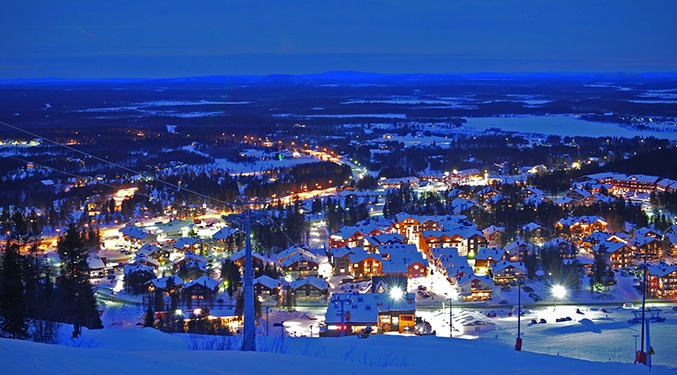
By Levimatkailu (CC BY-SA 4.0 licence)
In recent years Levi in Lapland has been growing fast to become Finland’s biggest and most popular ski resort, and world cup alpine races are held here.
This winter wonderland allegedly has some of the cleanest air in the world, and there’s certainly something magical about the place with its atmospheric mists, diamond dusted pine trees, and glittering frozen lakes.
Thanks to Levi’s northerly location, the long days during March and April allow for 16 hours of skiing under brilliant sun, with night skiing is possible at this time without any kind of artificial light. World class skiing is on offer here in 102 skiable acres with a 1066 foot vertical, and 27 miles of largely uncrowded, snow sure pistes well served by an efficient modern lift infrastructure.
17 slopes are floodlit for night skiing, and in addition to the pistes there are 230 km of cross country skiing, 890 km of snowmobile routes and 20 km of winter walking routes to be explored.
Of the 43 runs, 3 are black, 21 red, and 18 are blue. Pistes are varied, and include long and easy forest runs and wide, spacious family runs, challenging steeps, groomed cruisers, and an official FIS World Cup slalom course to put the experts through their paces.
Levi boasts no less than 3 top notch terrain parks featuring half-pipes, triple pipe, and a choice of jumps and obstacles and a variety of lines for beginner to advanced riders.
There’s lots here to appeal to families including several dedicated play areas, organized activities and a creche.
The international ski school runs, comprehensive programs for kids and courses for all skill levels.
And if all that isn’t enough there are a full range of aside from skiing and snowboarding, such as adventuring in the wilderness on a snowmobile or husky sled rides, going on a wildlife safari or visiting a reindeer farm.
Après is electric both on the slopes and at Levi Fell village. Restaurant V’inkkari on the Front slope, is the heart of Levi after ski fun, and it’s where the party gets started with live music and table dancing. Tuikku restaurant blasts out Finnish pop hits from afternoon until late.
Alternatively throw some shapes to live DJs on the biggest dance floor in Lapland at Hotel Levitunturi. There are a number of other bars and clubs to choose from too, including sports bars and karaoke bars. 60 restaurants are dotted around the resort, so there are plenty of options when it comes to eating out.
The Hotel Hullu Poro — aka the Crazy Reindeer — with a winning combination of a fun atmosphere and delicious Lapp cuisine is not to be missed.
There are also yummy bakeries, burger joints, sushi, steakhouses, pizzerias and seafood restaurants.
Pyhä

By Trainthh (CC BY-SA 3.0 licence)
Situated on the edge of the Pyhä-Luosto national park with a breathtaking backdrop of snow covered forest and icy lakes, Pyhä ski resort is undeniably beautiful — it’s even possible to get a glimpse of the Northen Lights here.
Finland’s national ski team have chosen this location as their training ground, and the resort has some seriously challenging terrain.
It’s well known for its extreme verticals, and is home to Finland’s steepest mogul slope which has been used as avenue for the Freestyle Skiing World Championships.
Natural snow cover is good, and in addition there are excellent snowmaking facilities. Despite having some pretty gnarly terrain, Pyhä is actually a fantastic resort for all abilities.
There are almost 12 km of pistes available with 7 lifts to transport skiers and boarders to the 14 runs, nearly all of which are long tree-lined blues and challenging reds, and there are some also some freeride and deep snow areas.
Those with less experience are better off sticking to the northern slopes where there is some wide, mellow piste and family slopes. It’s also worth a mention that the entire resort is carbon-neutral and eco friendly.
Unfortunately there’s not much in the way of après ski at the resort, however it’s still possible to have a good time here. The SkiBistro at the Hotel Pyhätunturi — Pyhä’s only hotel — has live music, and the Carlsberg House right by the Polar slope has booze, tunes, and a great atmosphere. There’s also a sports bar and a handful of restaurants.
Ylläs

By dr.eros (CC BY 3.0 licence)
A Finnish favorite, Ylläs has a foothold in the glorious Pallas-Yllästunturi National park — an area of outstanding natural beauty with rolling fells — and is known as the gateway to the wild north.
Ylläs is the biggest downhill and cross-country ski centre in Finland, and boasts the steepest vertical (1519 feet) of any Finnish ski resort, as well as the longest run — the Jättipitkä — at a length of 3 kilometres.
The majority of the 63 runs are fast, easy cruisers — in fact 60% of trails are green, making Ylläs the perfect playground for beginners, and there are two good ski schools at the resort.
Intermediates have plenty of space to play too, although there is little on piste action to be had for more advanced skiers and snowboarders.
Off piste the terrain can be challenging and there is nearly always plenty of good quality powder. For lovers of cross country skiing, there are a staggering 320 km of prepared trails at Ylläs, all with wonderful scenery.
There’s no real central hub at the resort, instead it is made up of two villages — Ylläsjärvi and Akäslompolo — where there are bars and restaurants, but things tend to be fairly sedate. The Akäs hotel is probably the most lively and popular venue for après drinks and dancing.
The restaurants in the resort are mainly traditional and serve all kinds of local delicacies — reindeer features heavily on the menus.
Best Ski Resorts in Iceland
Bláfjöll

By Reykholt (CC BY-SA 3.0 licence)
Just half an hours drive from Reykjavik lies Iceland’s biggest ski resort — Bláfjöll.
The ski terrain benefits from marvelous views across the volcanic landscape to the ocean, and is divided into 3 different areas with 16 ski lifts, much of which is floodlit for night skiing.
The maximum vertical drop at Bláfjöll is 720 feet, and there are 15 km of slopes with 19 runs — 4 black, 10 red, and 5 blue — for skiing and snowboarding.
Due to the resort’s low altitude snow cover is variable, but enough of the white stuff will enable you not just to enjoy the slopes at Bláfjöll ski resort, but also the 18 kilometers of cross country ski trails in the surrounding countryside.
There’s also a good ski school on site for kids aged between 5 and 12 years and a small selection of simple cafes and snack type restaurants at the base stations.
Bláfjöll can easily be reached by public buses which go directly to the resort from Reykjavík.
Hlíðarfjall

By sergejf (CC BY-SA 2.0 licence)
To the north east of Iceland Hlíðarfjall is a compact but varied ski resort with a 1640 foot vertical drop and reliable snowfall plus snowmaking.
The resort is one of Iceland’s premier skiing spots, and the views across to the fjords of Eyjafjörður to the impressive table topped Mount Herðubreið are breathtaking. The resort comprises 23 alpine slopes with 24 groomed pistes covering a combined length of 15km — much of which is lit up at night — with 7 ski lifts to ferry skiers from place to place.
The longest trail here is over 2.5 km long, and there’s a gently slopped bowl area ideal for those just starting out.
Children can get off to a flying start at the Hlíðarfjall Ski School for Children, and there are also ski and snowboard courses available.
Runs are nicely varied, with a good mix of trails, particularly reds and blues for advanced and beginner skiers.
Off piste there is exciting, steep alpine backcountry terrain waiting to be discovered and an extensive 15 km network of cross country tracks.
The snowpark features a good choice of rails and obstacles. If you work up a hunger there’s a restaurant on site, but there is very little else.
Fortunately the town of Akureyri with restaurants and bars is a mere 6 km away.
Tungudalur / Seljalandsdalur
Together the two neighboring resorts of Tungudalur and Seljalandsdalur make up the Isafjördur ski area in the Westfjords region.
Tungudalur is one of the four biggest ski areas in the country and is more or less dedicated to alpine skiing.
The slopes here are a little more diverse and there’s also a nursery slope for novices, as well as good snowboarding areas when the weather permits.
Seljalandsdalur has some wonderful groomed cross-country skiing and snowshoeing terrain, as well as some fabulous backcountry areas with gnarly couloirs, steeps, and sublime rolling hills.
Combined, the two resorts offer up 9 km of slopes and 3 ski lifts, with half the runs being blue and the other half almost evenly split between red and black.
There are two ski lodges close to both ski areas which offer food and drink, one of which has overnight accommodations.
Best Ski Resorts in Romania
Poiana Brasov
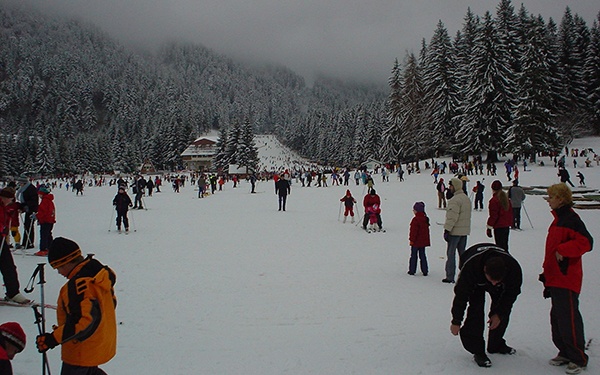
By Surovyi (CC BY-SA 3.0 licence)
Deep in the mysterious Transylvanian Carpathian mountains not for from Dracula’s famous castle lies Romania’s most popular resort — Poiana Brasov.
The pristine ski area has been the location for skiing competitions and events since 1951, and the resort has an alpine feel to it.
14 north facing slopes have a vertical drop of 2543 feet and maintain a snow coverage of around 24 inches during the winter months, and all slopes have the advantage of snowmaking coverage and some have floodlighting.
10 lifts including a cable car and gondola transport skiers and boarders around the pistes, which have a total length of 24 km, as well as 8.6 kilometers of cross country ski trails.
Beginners and intermediates will have a blast at Poiana Brasov.
There are wide, gentle nursery slopes, plus the longest easy slope in the country at 5600 m, and a good mix of blue and red runs (43% and 20% respectively) with lots of possibility for progression.
The Wolf slope and the 1035 m long Ruipa slope are where more advanced skiers will have the most fun.
This is a very affordable resort, but it can get busy in high season.
The selection of après bars and discos is spirited, and there is a fun atmosphere throughout. For relaxation and giving tired muscles a treat there is a lavish spa and wellness center complete with thermal pools.
Local Romanian delicacies can be sampled in many of the resort restaurants, and you’re sure to hear some live Romanian folk music being played in bars.
Sinaia
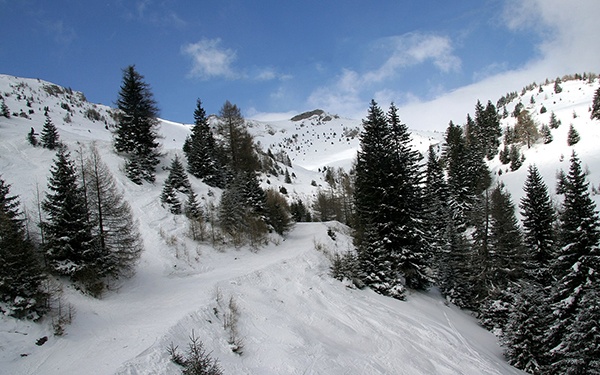
By John Salatas (CC BY-SA 4.0 licence)
Once a royal resort, Sinaia is the largest resort in Romania’s stunning Prahova Valley, which even featured as a stop on the Orient Express’s route to Istanbul, and it offers up some top notch skiing and snowboarding just east of the majestic Bucegi Mountains.
The 22 kilometers of slopes boast Romania’s biggest vertical descent at 3740 feet, with 10 ski lifts including 2 gondolas and 2 cable cars serving the 12 pistes, with the longest possible descent being 11 km long.
Of the 12 runs the majority are easy and intermediate, and Sinaia is a very popular resort among beginners who want to learn downhill skiing in the most sunny and snow sure ski resort in Romania.
32% (6.9 km) of pistes are available for the more advanced and expert level skiers and snowboarders, as well as a good amount of challenging off piste.
The resort village has a cozy chalet ambience. There are a few bars, restaurants, and a nightclub for après ski entertainment, including the popular H2O Après Ski bar.
Straja
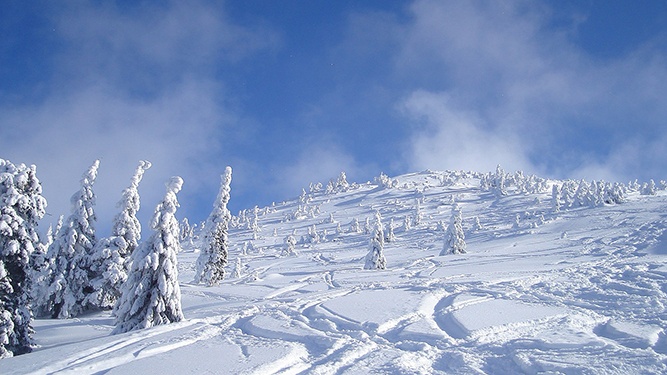
By Albundy64 (CC BY-SA 4.0 licence)
This up and coming Romanian ski resort in the northern part of Romania’s Vâlcan Mountains is fast becoming a contender to rival the people’s favorite resort Poiana Brasov and it’s definitely one to watch.
Modern and with constant improvements and expansion, the resort offers some sensational views, good snow cover, a vertical drop of 3661 feet, and currently has 26 km of ski area spread over 12 slopes, and the majority of the runs being relatively long and split into 20% blue, 40% red, and 40% black, offering some excellent intermediate and advanced terrain.
Crowds are rare at the resort, although this is sure to change as it increases in popularity.
There is accommodation available at the centre of the resort and a few bars, but many guests prefer to stay in nearby Lupeni town.
Best Ski Resorts in Italy
Sestriere
Italy’s first purpose built ski resort, Sestriere in the Piedmont region is not known for its beauty, but what it lacks in looks it more than makes up for with amazing advanced piste trails, a state of the art lift system, an excellent standard of accommodation, and superb snow conditions.
It’s also the gateway to the Via Lattea — aka the Milky Way — ski pass which links it up to 400km of additional glorious slopes.
There is normally reliable natural snowfall at the resort although it can occasionally be a little hit and miss, but Sestriere has that covered with extensive snowmaking capabilities.
The 58 pistes provide a pleasing 4865 foot vertical drop and are extremely well maintained. There are two main ski areas — Sises next to Sestriere village, and Motta with a higher altitude and a slightly wider choice of skiing options.
Overall there’s a good mix of terrain, with plenty of steep pistes, moguls and off piste action (snowfall permitting) for experts, plus two hair raising black runs, Kandahar Slalom Giovanni Alberto Agnelli run which has hosted countless Alpine Skiing World Cups, and the world class Col de Sises.
There are good facilities for beginners including good nursery slopes and easy, long progression runs. Confident intermediate and advanced skiers and snowboarders will get the most out of the rest of the runs.
The ski lift system is a melange of new and old, but the infrastructure is excellent and it’s very good value for money. Heliskiing at Sestriere is also an option for the adventurous.
Off piste free skiing is on offer if accompanied by a local guide.
Cosmopolitan and with a vibrant atmosphere, Sestriere ski resort village attracts well-heeled Italians and visitors from all over the world.
Stylish boutiques, bars and cafes can be found on every street, and there are some great drinking and dining options on the mountain too.
Top après spots include the welcoming Pinkies Pizzeria, and Brahms pub and the Irish Igloo bar for live music and a fun vibe. Tabata disco is the resort nightclub. Dining options range from pizzas and pasta to local specialities and sophisticated fine dining.
Cortina d’Ampezzo
Jaw droppingly beautiful, the Dolomites in Northern Italy possess rolling hills, rugged mountains and forests, and picture perfect lakes, all kissed by the rosy glow of sunlight.
There are several ski resorts in the area, but of all of them Cortina d’Ampezzo is undeniably the jewel in the crown of this intoxicating natural wonderland.
The resort town is sophisticated, and the skiing is diverse, with 120 km of pistes over 105 acres serviced by 39 lifts including 5 gondolas, a staggering vertical of 5794 feet, and both natural and artificial snow coverage to ensure optimum ski conditions.
The resort is a famous racing town, yet the slopes remain peaceful, all the better for making the most of the seriously rewarding terrain.
The 73 runs are divided into 33% beginner, 45% intermediate, and 16% advanced. Beginner areas are sheltered and well serviced, and the lower sections of the Pomedes area has some of the biggest and best nursery slopes and progression runs.
Intermediate skiers can take advantage of very varied terrain all worthy of discovery, including fast cruisers, steeps, and tree skiing.
A good selection of sunny couloirs and off piste runs provide challenging terrain for advanced and expert skiers, with high alpine meadows & bowls as well as demanding couloirs and chutes.
The large resort town is a traditional stronghold for wealthy, well-heeled Italians, and there’s a high dose of glitz and glamour here with high end boutiques, cocktail lounges, and world class restaurants.
The après ski is generally quite refined, and there are are some wonderful wine bars which are perfect for people watching at the end of the day.
Enoteca and Lovat are two of the favorite après spots, and although not a huge number of bars are open late, the Hippo and Limbo nightclubs are perfect for partying into the early hours.
Gourmet food lovers will certainly have enough to salivate over at Cortina d’Ampezzo. Among the many top quality restaurants on offer in the multi-award winning and romantic Rifugio Averau which serves up elegant European cuisine accompanied by stunning panoramic views of the Dolomite landscape from the terrace.
For those on a budget — this may not be the resort for you — but there are a handful of decent snack bars and cheaper eateries.
Val Gardena
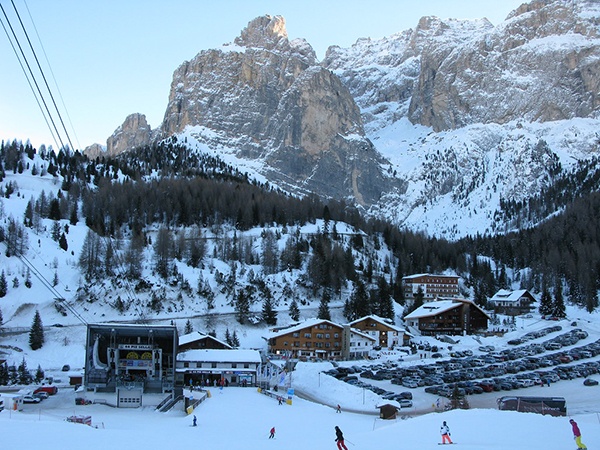
By Leo-setä (CC BY-SA 2.0 licence)
A melting pot of different European cultures, Val Gardena in the Dolomite region is a world class ski destination with unsurpassed scenic views, family friendly, and exciting ski terrain.
Three different resort centers make up the Val Gardena ski area — Ortisei, Santa Cristina,and Selva Gardena.
Overall there are 175 acres to explore with a 4147 foot vertical drop, a seamlessly operated ski lift system, and nearly total snowmaking coverage.
With 30% blues, 60% red, and 10% blacks, there is tons of fun to be had for all abilities. The Alpe di Siusi is the prime area for beginners and families, with gentle learning slopes and good options for progression onto some easy blues.
Intermediate to advanced skiers are in their element here, with an immense amount of varied on piste terrain.
Experts will find plenty to amuse on the black rated pistes and just cruising the enjoyable reds and blues, but those wanting an extreme ski experience may be better off looking elsewhere.
Equally, snowboarders may not find that Val Gardena suits their needs best, although there are 3 terrain parks with kickers, rails, jumps , and tunnels for freestyle fun.
Take advantage of the Skipass Dolomiti Superski and the slopes are your oyster, with access to all lift facilities in the Dolomites providing an astounding 500 km of interconnected slopes and a total of 1220 km slopes spread over 12 zones.
The resort’s 3 villages provide plenty in the way of après ski fun, with a choice of cozy bars with life music and cheap drink deals.
The pleasant, traditional main village of Selva is brimming with Tyrolean style charm, and has the most on offer in terms of bars, late night spots, and restaurants.
Both German and Italian are widely spoken here. Bar La Stua and La Bula both have live music acts, the latter having DJs pumping out tunes as soon as the lifts close.
The Luislkeller is a friendly venue that remains open until 1 am.
There are many huts on the mountains offering hearty fare fit to fuel even the most ravenous. Many dish up tasty regional specialties, but there’s also a fair share of pizza places and fine dining establishments.
Where do you think is home to the best ski resorts in the world?

